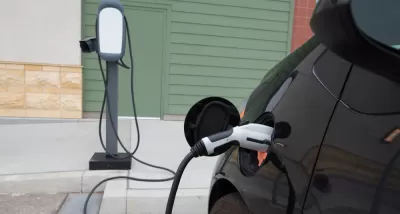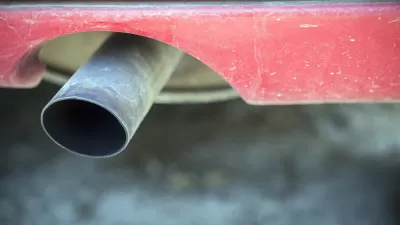With the formal announcement by the EPA and the U.S. DOT on Thursday that the "One National Standard" rule has been issued, California's zero-emission standard, which applies to ten other states, is essentially on hold.

InsideClimate News' Marianne Lavelle looks into how the revocation by the U.S Environmental Protection Agency (EPA) and U.S. Department of Transportation (USDOT) of the waiver granted to California in the 1970 Clean Air Act will affect electric vehicle (EV) sales in California and the ten other states that have adopted the California Zero-Emission Vehicle (ZEV) Program.
Lavelle also observes that in the U.S., like California, transportation emissions increased in 2017 while total greenhouse gas emissions decreased.
"Simply put, the California Waiver has enabled greater EV penetration in markets nationwide," said ChargePoint, the world's largest EV charging network, in comments it filed with the federal government last year. Revoking the California waiver would "stifle EV markets across the country at a time of rapid growth," ChargePoint said.
With the formal announcement of the "Final Rule: One National Program on Federal Preemption of State Fuel Economy Standards," the outlook for electric vehicle sales in the U.S., already at risk due to Trump's deregulation policies, becomes dimmer.
California has led the nation in a slow, but steady move toward electric vehicles—a turnover that experts believe is essential for gaining control of rising U.S. carbon emissions from transportation. Ten other states had adopted its rules requiring automakers to sell a certain number of electric cars and trucks, based on each manufacturer's overall in-state sales.
Those ten states, known as Section 177 (of the Clean Air Act) States, are Connecticut, Maine, Maryland, Massachusetts, New Jersey, New York, Oregon, Rhode Island, and Vermont. Colorado joined the group last month.
But California and those other states now lose the power to enforce those zero-emissions vehicle requirements—at least temporarily.
Auto industry experts and analysts expect the uncertainty that would create would dampen the market for zero-emissions vehicles [ZEVs].
ZEVs needed!
2017 was the first year where greenhouse gas emissions exceeded those from the power sector, responsible for a plurality of the nation's greenhouse gas emissions, with light-duty vehicles responsible for 59% of emissions in that sector.
Increases in vehicle miles traveled (VMT) have outpaced improvements to the fuel economy of the nation's fleet of light-duty vehicles. "Carbon emissions from transportation grew 1.2 percent in 2017 even as the nation's overall carbon emissions fell 0.5 percent, according to the latest figures from the Environmental Protection Agency," notes Lavelle.
As long as more consumers are driving more miles each year, only electric and other zero-emissions vehicles can reverse the trend that has made transportation the largest source of U.S. greenhouse gas emissions.
But don't discount VMT reduction
Transportation for America might take issue with that assertion. "Despite an admirable 35 percent increase in the overall fuel efficiency of our vehicle fleet from 1990-2016, emissions still rose by 21 percent," writes Emily Mangan on Sept. 16.
Why was that? Because the total amount of miles traveled increased by 50 percent in that same period. Simply put, we’ll never achieve ambitious climate targets if we don’t reduce driving.
The California Air Resources Board issued came to the same conclusion in a November 2018 progress report on "sustainable communities" legislation.
EV sales outlook was bright
"New registrations of EVs in the United States more than doubled in 2018 to 208,000, with nearly 46 percent of that growth occurring in California. An additional 13 percent were in the nine states that have adopted that state's zero-emissions rules, according to the consulting firm IHS Markit," adds Lavelle.
EVs are on track to grow from 2 percent of the total U.S auto fleet in 2020 to more than 7 percent by 2025, IHS Markit said in April. But the consulting firm added, "The greatest headwind for EV sales in the U.S. may soon be any elimination or delay to California's Zero Emission Vehicles (ZEV) mandate by the federal government."
Part I of SAFE Rule now finalized
"This action finalizes critical parts of the Safer, Affordable, Fuel-Efficient (SAFE) Vehicles Rule that was first proposed in August 2018," states the summary of the EPA/USDOT summary of the One National Program Rule, dated Sept. 19.
The remaining parts of the Trump Administration's rollback of fuel economy/greenhouse gas emissions standards rule for passenger cars and light-duty trucks for model years 2021 through 2026, which freezes standards at 2020 levels at about 36 mpg, is expected to be finalized later this year.
Related in Planetizen:
-
Automakers Required to Increase EV Sales in Colorado, August 23, 2019
-
U.S. Risks Becoming Backwater for Electric Vehicle Sales, March 11, 2019
FULL STORY: Trump Strips California’s Right to Set Tougher Auto Standards

Planetizen Federal Action Tracker
A weekly monitor of how Trump’s orders and actions are impacting planners and planning in America.

San Francisco's School District Spent $105M To Build Affordable Housing for Teachers — And That's Just the Beginning
SFUSD joins a growing list of school districts using their land holdings to address housing affordability challenges faced by their own employees.

The Tiny, Adorable $7,000 Car Turning Japan Onto EVs
The single seat Mibot charges from a regular plug as quickly as an iPad, and is about half the price of an average EV.

Seattle's Plan for Adopting Driverless Cars
Equity, safety, accessibility and affordability are front of mind as the city prepares for robotaxis and other autonomous vehicles.

As Trump Phases Out FEMA, Is It Time to Flee the Floodplains?
With less federal funding available for disaster relief efforts, the need to relocate at-risk communities is more urgent than ever.

With Protected Lanes, 460% More People Commute by Bike
For those needing more ammo, more data proving what we already knew is here.
Urban Design for Planners 1: Software Tools
This six-course series explores essential urban design concepts using open source software and equips planners with the tools they need to participate fully in the urban design process.
Planning for Universal Design
Learn the tools for implementing Universal Design in planning regulations.
Smith Gee Studio
City of Charlotte
City of Camden Redevelopment Agency
City of Astoria
Transportation Research & Education Center (TREC) at Portland State University
US High Speed Rail Association
City of Camden Redevelopment Agency
Municipality of Princeton (NJ)




























